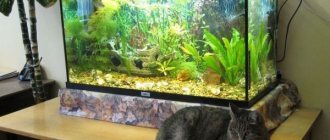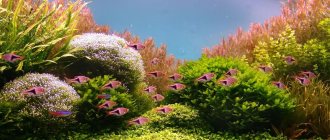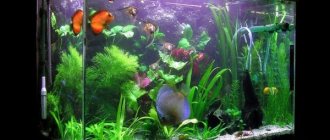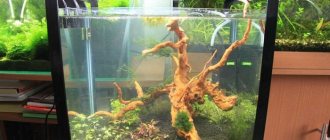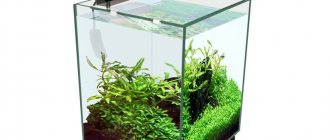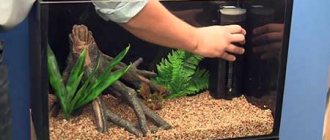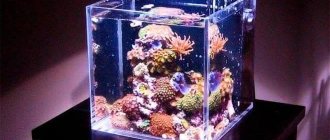Choosing an aquarium
150-liter aquariums can have different configurations. In stores you can find rectangular, cubic, hexagonal, corner and panoramic containers. The choice of shape depends on the interior of the room and the place where the aquarium will be located. It is believed that corner tanks take up less space, while rectangular tanks are easier to maintain and more comfortable for the fish.
The dimensions of a 150 liter aquarium may vary and depend on the specific model. The approximate dimensions of the rectangular tank are 95x40x42 cm.
Which types to choose?
The 150 liter aquarium is available in various variations:
- In the shape of a cube.
- Panoramic models.
- Corner models.
- Hexagonal models.
- Rectangular models.
Each tank shape (all photos are available online) has optimal visibility. Hexagonal containers require a little space. Corner tanks are used if there are free corners in the room. Panoramic, cubic and rectangular shapes are easy to care for.
Equipment
An aquarium with 150 liters of water becomes very heavy after filling, so you need to determine in advance the place where it will stand. The stand must be stable, level and strong, capable of supporting the weight of the artificial reservoir. It is best to purchase a special aquarium cabinet of a suitable size. A sheet of soft material (for example, polyurethane or polypropylene) is placed between the surface of the cabinet and the bottom of the aquarium to get rid of possible irregularities, which may later cause cracks in the glass.
To create comfortable conditions for aquarium inhabitants, the tank is equipped with the necessary equipment. An artificial reservoir must have:
- filter;
- compressor;
- heater;
- lighting devices – lamps with fluorescent or LED lamps.
General instructions for setting up an aquarium
It must be remembered that an aquarium is a separate ecosystem in your home, when creating which it is important to take into account the following requirements:
- appearance; the main requirement for a home aquarium is that the owner must like it; creating a composition allows you to show your own imagination and enjoy the process itself; although, if you wish, you can turn to specialists - aquarium designers;
- compliance with the main purpose; in principle, you can depict anything, but it’s still worth remembering that an aquarium is an artificial reservoir for keeping fish and plants;
- the reality of embodiment; giving freedom to your own imagination is wonderful, but it is desirable that all the elements for the implementation of your plans actually exist;
- manufacturability; it is necessary to understand that an aquarium is not just an art object, but an artificially created environment that can be maintained; access to equipment for repair or replacement, plants for pruning and weeding, and soil for cleaning is required.
Decor
Setting up a 150-liter aquarium is an important stage in arranging an artificial reservoir. The dimensions of a tank of this volume allow you to create an interesting design inside it that is in harmony with the interior of the room.
The background is attached to the back wall. It can be plain or with an image of the underwater world. A correctly selected background allows you to visually increase the internal space of the aquarium and emphasize the beauty of fish and plants. Soil is laid in a layer of 4-5 cm at the bottom of the reservoir. You can use a nutrient substrate for plants.
An important element of an aquarium is decoration. Using various decorative items, you can decorate your artificial pond in different ways. To create a natural design, natural driftwood and stones are suitable. For decorative style, artificial elements are used - caves, grottoes, ships, chests, etc.
Fashion in aquarium design
An aquarium is the visually most significant element of any room. Today it is not just a jar with fish - it is a product of a separate art direction of design thought.
Previously, aquarists were very limited in the means they could design their aquariums. The number of species of fish and plants was small, and all the decor had to be found in nature, spending a lot of time and effort.
Now aquarium farming is a whole industry with the production of necessary equipment, care products and a wide variety of food. All this made keeping an aquarium an enjoyable hobby. Now you can escape from purely practical aspects and create your own ideal corner of wildlife “for the soul.”
You can immediately begin choosing a design style for the aquarium, of which there are a great variety.
Natural
A natural aquarium is as close as possible to a piece of a natural body of water. Usually they try to recreate the atmosphere of a specific place where fish and aquatic plants live. The following types of real landscapes are often reproduced:
- rocky ridges; the basis of such an aquarium is stones of various sizes and textures; their installation should imitate mountains; driftwood and plants serve as additional decorative elements;
- tropical jungle; here driftwood and plants imitating tree trunks and crowns are the basis of the composition; they can be supplemented with moss and a small amount of stones;
- island; here the volume of driftwood and stones is distributed approximately equally; the composition itself can be round - located in the center of the aquarium or triangular - closer to one of the rear corners.
Aquascape
The word itself means “water landscape”. Creating aquascapes is actually a branch of landscape design that requires not only knowledge about the biology of fish and plants, but also an understanding of the laws of composition. Great importance is paid to the harmony and proportionality of the various elements of the aquarium. Decorating a small aquarium in this style will look impressive.
Herbalist
The basis of an aquarium of this type is plants, which should occupy from 20 to 80% of the total volume. Accordingly, the care of an herbalist is aimed primarily at plants. They must receive sufficient lighting, fertilizers and the required concentration of carbon dioxide in the water.
For better rooting of plants, lightweight nutrient soils are often used, spreading them in a layer of about 5 cm. When planning an herbal garden, tall plants (for example, pinnate and elodea) are usually planted along the back wall, and low ones (various cryptocorynes) are closer to the front.
This enhances the perspective. When populating such an aquarium, it is undesirable to use fish species that eat plants or undermine their roots. There are 2 types of herbalist:
- unforced - plants grow naturally in it, without shaping by pruning and replanting;
- forced - here the plants are carefully looked after, pruning them and feeding them.
Dutch
This style originates in the 1930s in Holland. Its basis is adherence to the multi-level principle. This is achieved through the construction of terraces and the use of low plants in the foreground, and continuous thickets in the background. There is also an increase in plant growth towards the side walls. At the same time, the entire bottom area is planted with them, with virtually no empty spaces.
In this case, plants are planted in picturesque groups of 10-12 cm2 of area. In total, a Dutch aquarium uses 10-12 types of vegetation. The color scheme of the plants in the Dutch aquarium in the photo is in green, red and olive shades.
Types with light leaf patterns are popular. For example, cabomba of various shades and rotala with different leaf shapes will look interesting.
Stones and driftwood are used minimally, and only in the central part of the composition. Fishes are also not of primary importance, and they are not always used. But to combat green algae, shrimp are often placed in the aquarium.
For a comfortable combination of colors, a darker background is usually used - black or brown.
Collector's
Collector style is a simplified version of Dutch, suitable for beginners. In fact, these are aquariums specialized for growing plants, a kind of underwater garden bed. Unlike the Dutch style, there are no requirements for the volume, shape and content of the aquarium. Plants are allowed to grow as they please, which creates a somewhat neglected appearance.
In any order, you can combine long- and short-stemmed, ground cover and floating aquarium plants of various types. Fish and shellfish can also be of any kind. This option is great for small aquariums with a volume of about 30 liters.
Plot
The design of this type of aquarium is organized according to a specific theme. Often they use national color, plots of films, myths and literature. Fish and plants here serve only as a background. The main emphasis is on the decorations and small nuances of the aquarium design.
Often, story aquariums are created for children or fans of certain works of popular art.
This type of aquarium provides enormous scope for the manifestation of creative nature.
Pseudo-sea
This is a fresh water aquarium, stylized as a sea one. To emphasize this trend, such aquariums usually use sea shells, corals and ship-themed decor.
White sand is often used as soil, and sea pebbles as stones. To enhance the effect, install lamps with blue backlighting. But you need to know that they cannot be turned on for more than 5 hours a day, otherwise this may provoke rapid growth of algae.
Vanguard
An avant-garde aquarium is a bold decision. This is a combination of acidic colors, unusual decor and neon lighting. It definitely won't fit into any interior. It is usually chosen by extraordinary and creative people who look at the world in their own way. An aquarium of this style would be appropriate in the hall or living room. Various types of nymphs are perfect for its landscaping.
Japanese
The Japanese style does not have the multicolor and decorativeness of European aquariums. Everything here is very concise - there are few elements, but they are all carefully verified. A lot of free space creates a feeling of naturalness and harmony. These landscape water gardens are designed for relaxed observation and meditation.
This style has the following aquarium design options:
- iwagumi; the central element is sunken ships plus small plants and stones;
- wabi-kusa; the central element is a picturesque hummock peeking above the surface of the water and covered with moss;
- rock garden; the central element is natural stones of various shapes, assembled according to a certain pattern;
- reboku; the central element is picturesque driftwood of an original shape.
Taiwanese
Aquariums of this style involve reproducing a purely land-based human habitat. Plants should be similar to familiar trees and grass, for example, Indian hygrophila and lemongrass are suitable.
The decor is made in the form of buildings and other structures, and the decor is complemented - be made in the form of buildings and other structures, and complemented by figures of people and pets. The only thing that often reminds us that this is an aquarium is the fish.
Antique
The design of this type of aquarium aims to create a feeling of ancient times. The main thing here is the decorations in the form of small copies of dilapidated temples, arches and columns, amphorae and figurines.
Fish and plants should not distract attention from them. Standard hornwort and various types of kabomba will do. Such an aquarium requires constant care - many decorative elements must be cleaned regularly, otherwise they will lose their attractive appearance.
Based on fairy tales
This type of aquarium is most often made for children. His aquarium design is created based on the plot of a specific fairy tale or cartoon. For example, the style of the fairy tale “The Little Mermaid” is very popular. To implement it you will need the following things:
- colored corals – natural or artificial,
- sea stars,
- interestingly shaped shells,
- underwater flowers - most likely plastic,
- famous sculpture of a boy,
- long algae, preferably swaying under the influence of the aerator; For example, red Matogros pinnate and species of Vallisneria spiralis are perfect,
- bright tropical fish of unusual colors and shapes (angelars, barbs, gouramis, telescopes, etc.)
And the child’s room will be decorated with a beautiful little mermaid sea garden.
Plants
In a 150-liter volume you can grow almost any type of aquarium plants. To avoid cluttering the space, specimens with large and wide leaves should be avoided. For a beginner's aquarium, unpretentious representatives of aquatic flora are suitable - cryptocorynes, anubias, vallisneria, echinodorus, bacopa, hornwort, elodea.
To create a beautiful design, you should pay attention to the placement of plants in the tank. Long-stemmed and fast-growing species are planted along the back wall. The brightest and most exotic specimens are placed in the center. Low-growing, slow-growing plants are placed in the foreground. Driftwood and stones can be decorated with mosses. To create diffused lighting and provide shelter for fish, floating plants (for example, riccia) are added to the aquarium.
Plants used
A) Purple Lobelia (Lobelia cardinalis);
B) Pogostemon helferi;
C) Creeping Staurogyne (Staurogyne repens);
D) Cryptocoryne wendtii “brown”;
E) Ludwigia glandulosa;
F) Pogostemon erectus;
G) Echinodorus "Vesuvius")
H) Dwarf Vallisneria (Vallisneria nana);
I) Hygrophila difformis;
J) Green pinnate (Myriophyllum mattogrossense “Green”);
K) Bacopa caroliniana.
How many and what kind of fish can you keep in a 150 liter aquarium?
A 150-liter aquarium can be used to keep both a group of fish of the same species and several schools of fish of different species. The maximum number of specimens that can be stocked in a tank of this volume depends on the size, nature and behavioral characteristics of representatives of the selected species of aquatic organisms. On average, it is believed that for every centimeter of a fish’s body length there should be at least 2 liters of water.
A 150-liter artificial pond is suitable for keeping the following types of fish:
- Black-striped cichlazomas (2-4 pieces). These are cichlids no larger than 10 cm in size. They are characterized by pronounced territorial behavior and aggressiveness towards other fish during the spawning period, so it is better to select representatives of the same species or other comparable cichlids as neighbors. Cichlazomas love clean, oxygenated water. To avoid fights for territory, shelters are placed in the aquarium.
- Gourami (3-24 pieces depending on the type). These are labyrinth fish, the size of which in adulthood is 4-15 cm, depending on the species. They are unpretentious and hardy, able to live in a tank without additional aeration, as they use atmospheric oxygen for breathing. Gourami do not tolerate cold water well; the optimal temperature for them is 25-27°C, so there should be a heater in the pond.
- Telescopes (2-4 pieces). This is one of the selected forms of goldfish, characterized by a short body and large bulging eyes. In adulthood, telescopes reach sizes of 15-20 cm. Due to the structure of the fish’s eyes, they are easily injured, so the soil particles should be large and smooth, and the decorations should not have sharp corners. Fish quickly pollute water, so good filtration and aeration are necessary.
- Cardinals (25-30 pieces). These are fish up to 4 cm in size. The color is greenish-gray with red fins and a bluish-green shiny stripe running along the body. Cardinals are kept in a flock at a temperature of 15-22°C in an aquarium with dense thickets of plants. These fish are peaceful and get along well with other non-aggressive, sized species.
- Angelfish (2-3 pieces). These are tall-bodied cichlids with long fins, reaching a length of 15 cm and a height of up to 30 cm. Due to this feature of the body structure, it is better to keep these fish in aquariums with a height of 50 cm or more. Angelfish are peaceful, but can eat fry and small fish. They do not dig the soil and do not damage plants.
- Guppies (35-40 pieces). These are peaceful, viviparous fish up to 6 cm in size, known for their unpretentiousness and ability to adapt. They are brightly colored, mobile, occupy all layers of water in the aquarium, and feed on both live and artificial food. Guppies love bright lighting, clean, oxygenated water with a gentle current. Well suited for aquariums with thickets of plants.
- Ternetias (10-15 pieces). These are fish up to 5 cm in size. A characteristic feature of the species is a developed black anal fin. In the aquarium, thorns stay in a flock. They do not like bright light, so floating plants should be placed in the pond. The tank is covered with a lid to prevent the fish from jumping out. Ternetias love clean, oxygenated water and dense thickets of plants.
- Goldfish (2-3 pieces). These are popular aquarium inhabitants, the size of which reaches 10-30 cm depending on the breed. These large fish are quite mobile and require a lot of space for swimming, so it is recommended to keep them in rectangular, horizontally oriented aquariums up to 50 cm high. Goldfish love to dig in the ground, so the particle size should be such that the fish do not swallow them.
- Neons (30-35 pieces). These are schooling fish 3-4 cm in size. A characteristic feature is a shiny blue stripe along the body. Thanks to this feature, flocks of neons look impressive against the backdrop of dense vegetation. These fish are peaceful and calm, do not damage plants or dig the soil. They love dim lighting and good filtration.
- Ancistrus catfish (1-3 pieces). Ancistrus are peace-loving, unpretentious fish up to 15 cm in size. They spend most of their time scraping algae and plaque from glass, soil, decorations and plant leaves. They are most active at dusk, so it is advisable to create dim lighting in the aquarium. Good aeration and shelter are important.
Basic techniques for filling aquariums
There are many formulas, the basis of which is a comparison of the total length of the fish and the volume of the aquarium.
Example: “For 1 cm of fish you need 1-2 liters of water.” Such calculations can be immediately rejected as untenable. Those that are compiled taking into account the physiological and characteristic characteristics of individuals can be considered more accurate. Such formulas are based not only on the length of the fish, but also on their fatness, the amount of waste excreted, aggressiveness and the need to live in a school. The ratio of the size of the aquarium to the size of the fish, as well as its surface area, is also important. It is known that the higher this indicator, the better the absorption of oxygen from the air.
Calculations can also be made by measuring surface area. For example, for small fish with a narrow oblong body, 90 cm² of surface is enough, and for large and “plump” fish, at least 150 cm². Formulas for measuring the area of a rectangle, square or circle (for those who have forgotten the school curriculum) can always be found on the Internet.
Large and schooling fish need large aquariums, small fish need small aquariums. This statement may sound like a truism, but just imagine how you will look for small guppies in a 100-liter aquarium, or how a 25-centimeter astronotus will feel in a 50-liter aquarium.
Other inhabitants
In addition to fish, you can also keep other aquatic animals in a 150-liter aquarium. This volume is well suited for keeping a group of shrimp of any type (Amano, crystals, neocaridines), as well as mollusks (ampularia, coils, helena, etc.). Shrimps and snails eat up the remaining food after the fish and also rid the aquarium of algae. In addition, the 150-liter volume can be stocked with crayfish. However, it should be remembered that these invertebrates hunt fish, like to dig the soil and tear off plant leaves. You can also put frogs in the tank - hymenochirus or clawed frogs. They do not require access to land, but can eat small fish.
Separate conversation
There are fish to which it is impossible to apply general concepts of population density.
Cichlids
The diversity of their species and behavioral characteristics does not allow us to talk about a uniform population density.
These are fish that are jealous of their own territory. It is believed that a slight overpopulation may slightly soften their aggressive nature. Small cichlids, up to 10 cm long (sage, blackstripe, sun), need aquariums of at least 40-60 liters per pair. As the aquarium grows, the population density increases. For example, up to a dozen black-striped cichlases can “live” in 150 liters.
Medium-sized cichlids, up to 30 cm (small Tangani and Malawian) need a larger aquarium - from 150 liters. As mentioned earlier, slight overpopulation is allowed - the volume is calculated from 10 liters per individual. Arranging the bottom will also help solve the problem of aggressiveness - they simply need places to hide (grottoes, snags, large bushy plants).
Bottom fish - suckers and burrowers
The number of catfish and bots, as a rule, is not taken into account in the total number of inhabitants of the aquarium, but their size should not be overlooked. For example, for 1 ancistrus you will need an aquarium of 50 liters, for 1 plecostomus - already 250.
Labyrinth fish
An exception to the general rules are labyrinth fish - they are practically indifferent to the oxygen content in the water. For example, a single cockerel will feel fine in almost a glass of water, and a couple of gouramis will feel fine in a 20-liter aquarium.
Starting and maintaining an aquarium
A 150-liter aquarium, soil and decorations are thoroughly washed with water without using detergents. For disinfection, the substrate and decorative elements can be doused with boiling water. Then the soil is placed on the bottom of the tank and the decorations are placed. Then water is poured into the aquarium and the filter is turned on, which should work around the clock. Plants are planted 1-3 days after starting. The lights begin to be turned on after planting, gradually increasing the length of daylight hours. After 3-7 days the fish are stocked.
Weekly aquarium care involves replacing 1/3 of the volume with fresh water. As it gets dirty, siphon the soil and clean the glass of deposits. Once a month, wash the filter and trim the plants.
Aquarium for beginners or how many fish should be in it
The question is, of course, interesting for a novice aquarist. There is a lot of data on the Internet, often incorrect, explaining how many fish can be put into an aquarium, based on the displacement/volume of the aquarium itself. Beginners, having read such data, release fish and have no idea how overpopulated their aquarium is.
It seems that they have done aeration, and there is a filter in the aquarium, but the fish are still getting sick and dying. And they change the water, and add vitamins, but the fish still die...
Simply, initially, a mistake was made, which consisted in the wrong selection of fish...
Any aquarium fish prefers its own layer of water in which it lives. There are fish that swim in the middle of the water column in an aquarium, and there are fish that scurry under the surface of the water. And there are also those that simply crawl along the bottom, for example catfish.
If you put a lot of zebrafish into an aquarium and sprinkle the surface of the water with riccia, then don’t expect anything good. Danio rerio prefers to scurry just below the surface of the water, and it is precisely this layer of water that you have re-compacted.
Throw a bunch of barbs, gouramis, and angelfish into the aquarium and you will get an over-compacted middle layer of water. True, barbs will clear space for themselves to live by simply killing and terrorizing angelfish and gourami.
Scary, right?! Well, who said that creating an aquarium is easy?!
How to choose the right fish for an aquarium and how many there should be
As I already wrote, fish prefer their own layers of water. How to determine in which layer of water a fish lives?!
Very simple, look at her mouth. If the mouth is turned upward, then this breed prefers the top layer of water, below the surface.
If the mouth is directed along the midline of the fish’s body, then it is a fish of the middle layer. If it looks down - bottom rock.
Accordingly, you need to select fish in such a way as to evenly populate all layers of water in the aquarium.
But here, when determining the number of fish for each layer, you need to calculate the volume of the aquarium and the size of the fish itself. Yeah, size also affects the number of fish in the aquarium, what did you think!?
How to decorate beautifully, stages of decoration
When decorating an aquarium, it is important to pay due attention to each element.
Background
A well-chosen background will emphasize the overall composition and visually increase the volume of the aquarium. The following materials can be used as a background:
- self-adhesive film with a printed image;
- a background of live or artificial plants attached to a grid;
- voluminous background made by yourself; its base can be made of polystyrene foam, polyurethane foam, rods, cork sheet, etc.; the main thing is to decorate it, efficiently and safely for the inhabitants;
- you can simply paint the outside of the back glass wall with any colors.
Priming
The soil performs two tasks: decorating the bottom and creating a substrate for planting. The well-being of both vegetation and fish depends on the choice of soil type. Beginning aquarists need to purchase ready-made soils from pet stores - this way they can avoid introducing poisons and parasites into the aquarium.
But the color, size and texture of the soil can be selected in accordance with the chosen style and conditions of keeping specific fish and plants. It can be quartz sand, stone or coral chips, small pebbles of various shades.
Stones
Natural stone will add scale and brutality to any aquarium. Artificial materials do not have this effect. Pebbles can completely cover the bottom of a saltwater aquarium. Individual large stones are used to anchor greenery and create accents. The most common types of stones:
- marble – this material is suitable for an aquarium with small algae;
- quartzite – the interesting texture of the stone goes well with larger plants;
- granite is a neutral option suitable for any style;
- gneiss - this striped stone will become a bright accent of the design;
- pebbles - rounded flat pebbles suit the marine style.
Do not use stone with sharp edges, such as laminated slate. Pisces can get hurt.
IMPORTANT: Sedimentary rocks containing lime greatly increase water hardness. They cannot be used. Vinegar helps to identify them. If, when applied, it begins to hiss and foam, this stone is not suitable.
Decorative elements
To more clearly define the style, different decor is used. Ships, grottoes and small statues will help emphasize the maritime theme. You can also come up with a lot of decorative elements to create themed aquariums. In addition, they all serve as shelters for fish. But it is important not to overload the pond with unnecessary details.
Vegetation
Aquarium plants are not only about decorating an aquarium. All of them are an important component of the ecosystem. Plants process nutrients from water and soil and release oxygen, lowering carbon dioxide levels.
They are an important stylistic detail and serve as a refuge for fish. Ground cover species can be used as soil.
Natural materials
Corals and shells will add a marine touch. Originally shaped driftwood will highlight Japanese or natural style. Half a coconut can provide a natural shelter for fish.
IMPORTANT: Do not use oak or conifer roots or branches. Tannins and resin are released from them, respectively.
Backlight
Without additional lighting, vegetation does not develop well and many species of fish also feel worse.
High-quality lighting can imitate natural ultraviolet rays or create a color nuance that works for the overall style. By playing with colors and turning on differently located lighting, you can change the mood of the entire composition. Using lighting, you can highlight individual objects or accentuate entire areas to create a special atmosphere.
But for lighting to complement the landscape, it must complement the chosen style and have a beneficial effect on the health of plants and fish. Lamps that are built into the lid of the aquarium are very practical.
They do not take up additional space and fit seamlessly into the design of the aquarium. As an example, we can take apart the domestic lamp Biodesign RIF 150/PANORAMA 140. Not only are all its components certified, it has a warranty period of 5 years and operating temperatures from -20º to +60ºС. There are 8 varieties of its illumination available, with different power and type of lighting, designed for different types of aquariums:
- for beginners,
- "slow" and advanced herbalists,
- biotopes,
- cichlids,
- pseudo-sea, etc.

